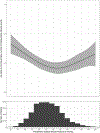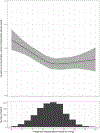Association between Preoperative Blood Pressures and Postoperative Adverse Events
- PMID: 38558232
- PMCID: PMC11233238
- DOI: 10.1097/ALN.0000000000004991
Association between Preoperative Blood Pressures and Postoperative Adverse Events
Abstract
Background: The relationship between postoperative adverse events and blood pressures in the preoperative period remains poorly understood. This study tested the hypothesis that day-of-surgery preoperative blood pressures are associated with postoperative adverse events.
Methods: The authors conducted a retrospective, observational study of adult patients having elective procedures requiring an inpatient stay between November 2017 and July 2021 at Vanderbilt University Medical Center to examine the independent associations between preoperative systolic and diastolic blood pressures (SBP, DBP) recorded immediately before anesthesia care and number of postoperative adverse events-myocardial injury, stroke, acute kidney injury, and mortality-while adjusting for potential confounders. The study used multivariable ordinal logistic regression to model the relationship.
Results: The analysis included 57,389 cases. The overall incidence of myocardial injury, stroke, acute kidney injury, and mortality within 30 days of surgery was 3.4% (1,967 events), 0.4% (223), 10.2% (5,871), and 2.1% (1,223), respectively. The independent associations between both SBP and DBP measurements and number of postoperative adverse events were found to be U-shaped, with greater risk both above and less than SBP 143 mmHg and DBP 86 mmHg-the troughs of the curves. The associations were strongest at SBP 173 mmHg (adjusted odds ratio, 1.212 vs. 143 mmHg; 95% CI, 1.021 to 1.439; P = 0.028), SBP 93 mmHg (adjusted odds ratio, 1.339 vs. 143 mmHg; 95% CI, 1.211 to 1.479; P < 0.001), DBP 106 mmHg (adjusted odds ratio, 1.294 vs. 86 mmHg; 95% CI, 1.003 to 1.17671; P = 0.048), and DBP 46 mmHg (adjusted odds ratio, 1.399 vs. 86 mmHg; 95% CI, 1.244 to 1.558; P < 0.001).
Conclusions: Preoperative blood pressures both less than and above a specific threshold were independently associated with a higher number of postoperative adverse events, but the data do not support specific strategies for managing patients with low or high blood pressure on the day of surgery.
Copyright © 2024 American Society of Anesthesiologists. All Rights Reserved.
Conflict of interest statement
Conflicts of Interest: Dr. McEvoy is a consultant for Takeda Pharmaceuticals and receives royalties from ASER Pain Medicine. Gen Li owns stock in Johnson & Johnson and Roche Holding AG. Dr. Freundlich owns stock in 3M and has received consulting fees from Phillips Healthcare and Oak Hill Clinical Informatics. The other authors declare no competing interests.
Figures



References
-
- Dix P, Howell S: Survey of cancellation rate of hypertensive patients undergoing anaesthesia and elective surgery. Br J Anaesth 2001; 86: 789–93 - PubMed
-
- Vazquez-Narvaez KG, Ulibarri-Vidales M: The patient with hypertension and new guidelines for therapy. Curr Opin Anaesthesiol 2019; 32: 421–426 - PubMed
-
- Whelton PK, Carey RM, Aronow WS, Casey DE Jr., Collins KJ, Dennison Himmelfarb C, DePalma SM, Gidding S, Jamerson KA, Jones DW, MacLaughlin EJ, Muntner P, Ovbiagele B, Smith SC Jr., Spencer CC, Stafford RS, Taler SJ, Thomas RJ, Williams KA Sr., Williamson JD, Wright JT Jr.: 2017 ACC/AHA/AAPA/ABC/ACPM/AGS/APhA/ASH/ASPC/NMA/PCNA Guideline for the Prevention, Detection, Evaluation, and Management of High Blood Pressure in Adults: Executive Summary: A Report of the American College of Cardiology/American Heart Association Task Force on Clinical Practice Guidelines. Circulation 2018; 138: e426–e483 - PubMed
-
- Fleisher LA: Preoperative evaluation of the patient with hypertension. JAMA 2002; 287: 2043–6 - PubMed
-
- Casadei B, Abuzeid H: Is there a strong rationale for deferring elective surgery in patients with poorly controlled hypertension? J Hypertens 2005; 23: 19–22 - PubMed
Publication types
MeSH terms
Grants and funding
LinkOut - more resources
Full Text Sources
Medical

